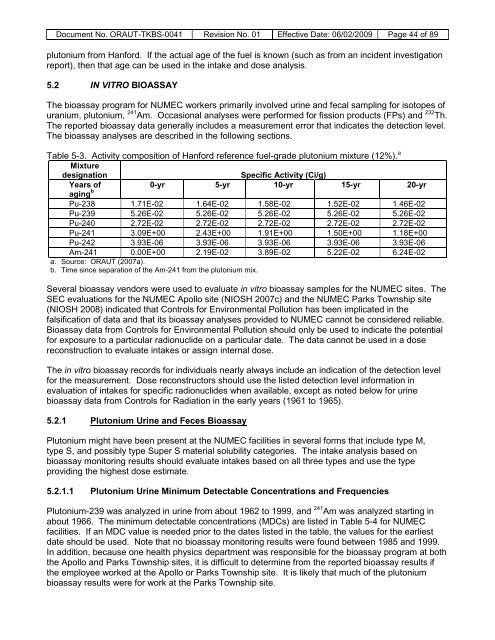ORAU TEAM Dose Reconstruction Project for NIOSH
ORAU TEAM Dose Reconstruction Project for NIOSH
ORAU TEAM Dose Reconstruction Project for NIOSH
Create successful ePaper yourself
Turn your PDF publications into a flip-book with our unique Google optimized e-Paper software.
Document No. <strong>ORAU</strong>T-TKBS-0041 Revision No. 01 Effective Date: 06/02/2009 Page 44 of 89<br />
plutonium from Han<strong>for</strong>d. If the actual age of the fuel is known (such as from an incident investigation<br />
report), then that age can be used in the intake and dose analysis.<br />
5.2 IN VITRO BIOASSAY<br />
The bioassay program <strong>for</strong> NUMEC workers primarily involved urine and fecal sampling <strong>for</strong> isotopes of<br />
uranium, plutonium, 241 Am. Occasional analyses were per<strong>for</strong>med <strong>for</strong> fission products (FPs) and 232 Th.<br />
The reported bioassay data generally includes a measurement error that indicates the detection level.<br />
The bioassay analyses are described in the following sections.<br />
Table 5-3. Activity composition of Han<strong>for</strong>d reference fuel-grade plutonium mixture (12%). a<br />
Mixture<br />
designation Specific Activity (Ci/g)<br />
Years of<br />
0-yr 5-yr 10-yr 15-yr 20-yr<br />
aging b<br />
Pu-238 1.71E-02 1.64E-02 1.58E-02 1.52E-02 1.46E-02<br />
Pu-239 5.26E-02 5.26E-02 5.26E-02 5.26E-02 5.26E-02<br />
Pu-240 2.72E-02 2.72E-02 2.72E-02 2.72E-02 2.72E-02<br />
Pu-241 3.09E+00 2.43E+00 1.91E+00 1.50E+00 1.18E+00<br />
Pu-242 3.93E-06 3.93E-06 3.93E-06 3.93E-06 3.93E-06<br />
Am-241 0.00E+00 2.19E-02 3.89E-02 5.22E-02 6.24E-02<br />
a. Source: <strong>ORAU</strong>T (2007a).<br />
b. Time since separation of the Am-241 from the plutonium mix.<br />
Several bioassay vendors were used to evaluate in vitro bioassay samples <strong>for</strong> the NUMEC sites. The<br />
SEC evaluations <strong>for</strong> the NUMEC Apollo site (<strong>NIOSH</strong> 2007c) and the NUMEC Parks Township site<br />
(<strong>NIOSH</strong> 2008) indicated that Controls <strong>for</strong> Environmental Pollution has been implicated in the<br />
falsification of data and that its bioassay analyses provided to NUMEC cannot be considered reliable.<br />
Bioassay data from Controls <strong>for</strong> Environmental Pollution should only be used to indicate the potential<br />
<strong>for</strong> exposure to a particular radionuclide on a particular date. The data cannot be used in a dose<br />
reconstruction to evaluate intakes or assign internal dose.<br />
The in vitro bioassay records <strong>for</strong> individuals nearly always include an indication of the detection level<br />
<strong>for</strong> the measurement. <strong>Dose</strong> reconstructors should use the listed detection level in<strong>for</strong>mation in<br />
evaluation of intakes <strong>for</strong> specific radionuclides when available, except as noted below <strong>for</strong> urine<br />
bioassay data from Controls <strong>for</strong> Radiation in the early years (1961 to 1965).<br />
5.2.1<br />
Plutonium Urine and Feces Bioassay<br />
Plutonium might have been present at the NUMEC facilities in several <strong>for</strong>ms that include type M,<br />
type S, and possibly type Super S material solubility categories. The intake analysis based on<br />
bioassay monitoring results should evaluate intakes based on all three types and use the type<br />
providing the highest dose estimate.<br />
5.2.1.1 Plutonium Urine Minimum Detectable Concentrations and Frequencies<br />
Plutonium-239 was analyzed in urine from about 1962 to 1999, and 241 Am was analyzed starting in<br />
about 1966. The minimum detectable concentrations (MDCs) are listed in Table 5-4 <strong>for</strong> NUMEC<br />
facilities. If an MDC value is needed prior to the dates listed in the table, the values <strong>for</strong> the earliest<br />
date should be used. Note that no bioassay monitoring results were found between 1985 and 1999.<br />
In addition, because one health physics department was responsible <strong>for</strong> the bioassay program at both<br />
the Apollo and Parks Township sites, it is difficult to determine from the reported bioassay results if<br />
the employee worked at the Apollo or Parks Township site. It is likely that much of the plutonium<br />
bioassay results were <strong>for</strong> work at the Parks Township site.

















